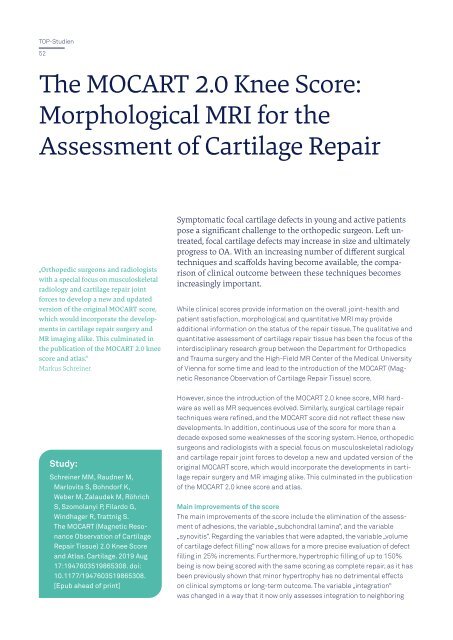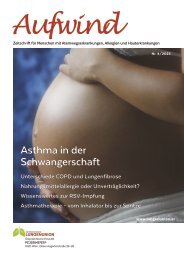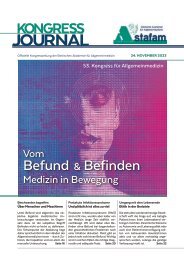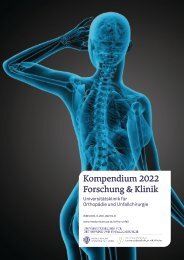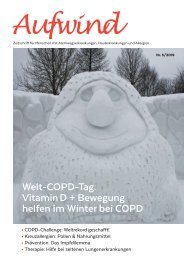Kompendium 2020 Forschung & Klinik
Das Kompendium 2020 der Universitätsklinik für Orthopädie und Unfallchirurgie von MedUni Wien und AKH Wien (o. Univ.-Prof. R. Windhager) stellt einen umfassenden Überblick über die medizinsichen Leistungen und auch die umfangreichen Forschungsfelder dar. Die Veröffentlichungen zeigen die klinische Relevanz und innovative Ansätze der einzelnen Forschungsrichtungen. Herausgeber: Universitätsklinik für Orthopädie und Unfallchirurgie MedUni Wien und AKH Wien Prof. Dr. R. Windhager ISBN 978-3-200-07715-7
Das Kompendium 2020 der Universitätsklinik für Orthopädie und Unfallchirurgie von MedUni Wien und AKH Wien (o. Univ.-Prof. R. Windhager) stellt einen umfassenden Überblick über die medizinsichen Leistungen und auch die umfangreichen Forschungsfelder dar. Die Veröffentlichungen zeigen die klinische Relevanz und innovative Ansätze der einzelnen Forschungsrichtungen.
Herausgeber: Universitätsklinik für Orthopädie und Unfallchirurgie
MedUni Wien und AKH Wien
Prof. Dr. R. Windhager
ISBN 978-3-200-07715-7
You also want an ePaper? Increase the reach of your titles
YUMPU automatically turns print PDFs into web optimized ePapers that Google loves.
TOP-Studien<br />
52<br />
The MOCART 2.0 Knee Score:<br />
Morphological MRI for the<br />
Assessment of Cartilage Repair<br />
„Orthopedic surgeons and radiologists<br />
with a special focus on musculoskeletal<br />
radiology and cartilage repair joint<br />
forces to develop a new and updated<br />
version of the original MOCART score,<br />
which would incorporate the developments<br />
in cartilage repair surgery and<br />
MR imaging alike. This culminated in<br />
the publication of the MOCART 2.0 knee<br />
score and atlas.“<br />
Markus Schreiner<br />
Symptomatic focal cartilage defects in young and active patients<br />
pose a significant challenge to the orthopedic surgeon. Left untreated,<br />
focal cartilage defects may increase in size and ultimately<br />
progress to OA. With an increasing number of different surgical<br />
techniques and scaffolds having become available, the comparison<br />
of clinical outcome between these techniques becomes<br />
increasingly important.<br />
While clinical scores provide information on the overall joint-health and<br />
patient satisfaction, morphological and quantitative MRI may provide<br />
additional information on the status of the repair tissue. The qualitative and<br />
quantitative assessment of cartilage repair tissue has been the focus of the<br />
interdisciplinary research group between the Department for Orthopedics<br />
and Trauma surgery and the High-Field MR Center of the Medical University<br />
of Vienna for some time and lead to the introduction of the MOCART (Magnetic<br />
Resonance Observation of Cartilage Repair Tissue) score.<br />
Study:<br />
Schreiner MM, Raudner M,<br />
Marlovits S, Bohndorf K,<br />
Weber M, Zalaudek M, Röhrich<br />
S, Szomolanyi P, Filardo G,<br />
Windhager R, Trattnig S.<br />
The MOCART (Magnetic Resonance<br />
Observation of Cartilage<br />
Repair Tissue) 2.0 Knee Score<br />
and Atlas. Cartilage. 2019 Aug<br />
17:1947603519865308. doi:<br />
10.1177/1947603519865308.<br />
[Epub ahead of print]<br />
However, since the introduction of the MOCART 2.0 knee score, MRI hardware<br />
as well as MR sequences evolved. Similarly, surgical cartilage repair<br />
techniques were refined, and the MOCART score did not reflect these new<br />
developments. In addition, continuous use of the score for more than a<br />
decade exposed some weaknesses of the scoring system. Hence, orthopedic<br />
surgeons and radiologists with a special focus on musculoskeletal radiology<br />
and cartilage repair joint forces to develop a new and updated version of the<br />
original MOCART score, which would incorporate the developments in cartilage<br />
repair surgery and MR imaging alike. This culminated in the publication<br />
of the MOCART 2.0 knee score and atlas.<br />
Main improvements of the score<br />
The main improvements of the score include the elimination of the assessment<br />
of adhesions, the variable „subchondral lamina“, and the variable<br />
„synovitis“. Regarding the variables that were adapted, the variable „volume<br />
of cartilage defect filling“ now allows for a more precise evaluation of defect<br />
filling in 25% increments. Furthermore, hypertrophic filling of up to 150%<br />
being is now being scored with the same scoring as complete repair, as it has<br />
been previously shown that minor hypertrophy has no detrimental effects<br />
on clinical symptoms or long-term outcome. The variable „integration“<br />
was changed in a way that it now only assesses integration to neighboring


